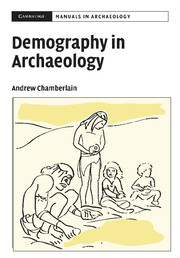Book contents
7 - CONCLUDING REMARKS
Published online by Cambridge University Press: 02 December 2009
Summary
THE RELEVANCE OF DEMOGRAPHY FOR ARCHAEOLOGY
Archaeology seeks to achieve an understanding of humankind through the study of the material remains of past cultures. In most circumstances these cultural remains are incomplete, and are often rather unrepresentative of the people and societies that generated them, therefore an important role of demographic studies within archaeology is to help place constraints on the kinds of populations that could have existed in the past and to evaluate the nature of the demographic processes that contributed to patterning in the archaeological record. A comprehensive and well-tested body of theory exists in anthropological and historical demography, so archaeologists do not need to depend on adventitious circumstances of preservation and recovery in order to achieve meaningful reconstructions of past population structures and processes. Although human societies are extraordinarily diverse, the demographic structure of any viable (i.e. self-sustaining, or demographically stable) population can be located within a limited range of possible variation. The application of this uniformitarian principle can be of great benefit to palaeodemography, firstly as a reality check when appraising the results of palaeodemographic analyses, and secondly as a source of prior probabilities for Bayesian and maximum likelihood estimation of population characteristics and parameters.
A wide range of important archaeological questions can be approached and addressed through palaeodemographic methods – these include the impact of environmental change on human populations; the nature of populational responses to changes in subsistence technology; the extent to which population expansion, migration and colonisation accompanied cultural change; the interaction between population structure and communicable disease; the balance of attritional and catastrophic mortality in past populations; the level of mortality attributable to warfare, infanticide and other forms of interpersonal violence; and the role of population processes in social conflict and cultural collapse.
- Type
- Chapter
- Information
- Demography in Archaeology , pp. 177 - 188Publisher: Cambridge University PressPrint publication year: 2006

